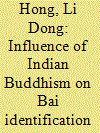| Srl | Item |
| 1 |
ID:
086289


|
|
|
|
|
| Publication |
2009.
|
| Summary/Abstract |
Exactly when Buddhism spread to the Lake Erhai region continues to be a hotly debated issue among scholars. Upon examining currently available documents and artifacts, however, one starts to see evidence that Indian Buddhism spread to the Lake Erhai region of western Yunnan from the 'Southern Branch of the Silk Road' by about the middle of the seventh century ad.Indian Buddhism has had a profound impact on Bai history and culture, most notably in (1) the spread and assimilation of Acaya Buddhism into Bai culture, and (2) the Bai perception that they are the descendents of King Asoka, India's famous early promoter of Buddhism.
|
|
|
|
|
|
|
|
|
|
|
|
|
|
|
|
| 2 |
ID:
166626


|
|
|
|
|
| Summary/Abstract |
How can minority writers within China assert their own ethnolinguistic distinctiveness whilst also writing in Chinese? Ethnic minority works fall into two groups: writing in standard Chinese, and works in native scripts. Most ethnic minority writing that can go beyond the local level to connect with a national or even global audience is published in Chinese – hence the label ‘Sinophone’ writing. The Bai people are one such minority nationality within China, who live in and around the city of Dali in ethnically-diverse Yunnan Province. Despite having their own language, they are often cited as one of the most ‘Sinicised’ of China’s ethnic groups. This means that the Bai are caught between two linguistic and cultural worlds: a situation that is reflected in their writing. As they write in Chinese, they translate their own language and culture, inserting non-Chinese words and cultural context, creating a new hybrid written form.
|
|
|
|
|
|
|
|
|
|
|
|
|
|
|
|